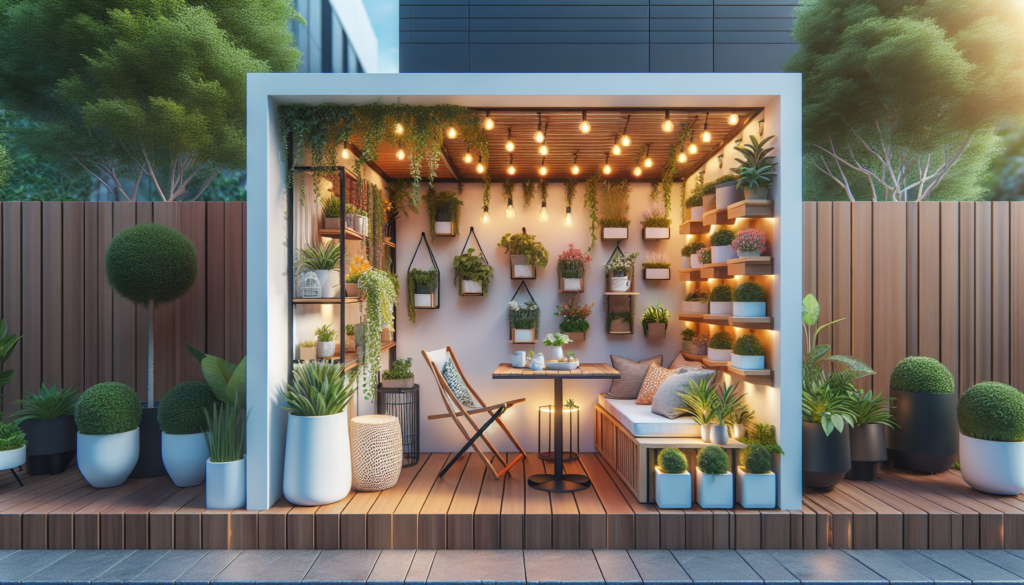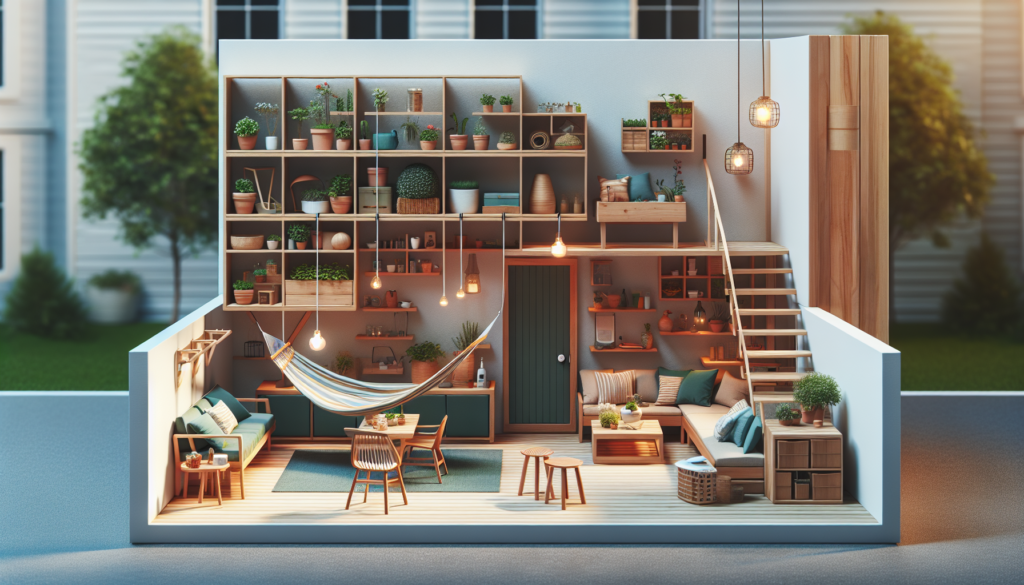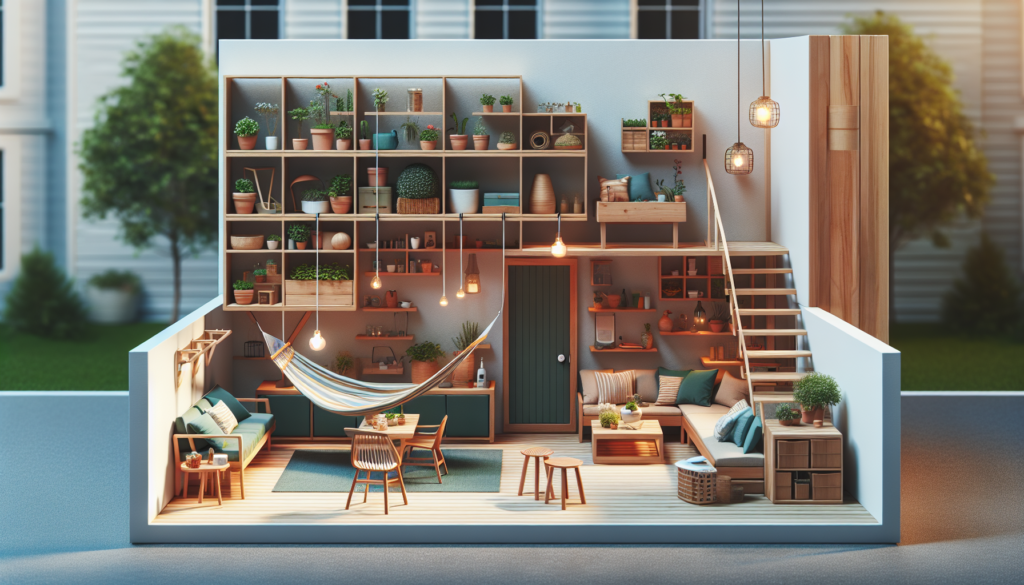Living in a small space doesn’t mean you have to sacrifice outdoor living. With a few strategic tips and tricks, you can downsize your outdoor space to perfectly complement your tiny living lifestyle. In this article, we’ll explore innovative ways to make the most out of your limited outdoor area, from selecting the right furniture and plants to creating functional zones that serve multiple purposes. Get ready to transform your tiny outdoor space into a cozy retreat that will make you feel like you have a spacious oasis just outside your doorstep.
Designing Your Outdoor Space
When it comes to designing your outdoor space, it’s important to start by understanding the purpose of the area. Are you looking to create a space for relaxing and unwinding? Or perhaps you want a space for entertaining and hosting gatherings? Once you have a clear idea of the purpose, you can better plan and design your outdoor space to meet your specific needs.
Consider your lifestyle and needs. Think about how you’ll be using the space on a regular basis. Do you enjoy gardening and need space for plants and flowers? Are you an avid cook who wants an outdoor kitchen area? Understanding your lifestyle and needs will help you make informed decisions about the layout and design of your outdoor space.
Create zones or areas within your outdoor space. This can help you utilize the space more effectively and create distinct areas for different activities. For example, you could have a designated dining area, a lounging area, and a gardening area. This way, each zone serves a specific purpose and allows you to make the most of your outdoor space.
Choose appropriate furniture and accessories for each zone. Make sure the furniture and accessories you select are suitable for the intended use of each zone. For dining areas, consider tables and chairs that are comfortable and easy to clean. For lounging areas, opt for cozy seating options and add cushions and outdoor pillows for extra comfort. Don’t forget to accessorize with items like umbrellas, rugs, and outdoor lighting to enhance the overall ambiance.
Maximizing Space Efficiency
When working with limited outdoor space, it’s crucial to maximize efficiency and make the most of every square inch. Here are some tips to help you do just that:
Opt for multifunctional furniture that serves multiple purposes. For example, consider benches with built-in storage or dining tables that can be folded down when not in use. These types of furniture allow you to save space while still providing functionality.
Utilize vertical space by incorporating hanging planters, wall-mounted shelves, or hanging storage solutions. This not only adds visual interest to your outdoor space but also maximizes the use of vertical space that might otherwise go unused.
Use foldable or collapsible items such as folding chairs, collapsible tables, or folding awnings. These items can be easily stored when not in use, allowing you to free up space for other activities.
Invest in space-saving storage solutions such as outdoor storage benches, vertical storage cabinets, or even a small shed. These storage options can help you keep your outdoor space organized and clutter-free.

Incorporating Greenery
Adding greenery to your outdoor space can transform it into a lush and inviting oasis. Here’s how you can incorporate greenery efficiently:
Choose container gardening for plants and flowers. This allows you to add greenery to your outdoor space without taking up too much room. Use decorative pots or containers that complement your overall design scheme.
Utilize hanging or wall-mounted planters. These are great for adding greenery to vertical spaces such as walls or fences. Hanging planters can also be used to create a cascading effect, adding visual interest to your outdoor space.
Create a vertical garden by using trellises, wall-mounted planters, or hanging baskets. This is an excellent option for maximizing space efficiency while still enjoying a variety of plants and flowers.
Consider low-maintenance plants that require minimal care and attention. Opt for drought-resistant plants or succulents that can thrive in various weather conditions. This allows you to enjoy a green outdoor space without spending too much time on maintenance.
Creating Privacy
Privacy is an important aspect when designing your outdoor space. Here are some ideas to create a private and secluded area:
Install privacy screens or fences around the perimeter of your outdoor space. This can help block the view from neighboring properties and create a more intimate setting.
Use outdoor curtains or shades to add privacy when needed. These can be hung on pergolas or other structures to create a secluded area for relaxation or entertaining.
Implement green privacy barriers such as trellises covered in climbing plants or hedges. These not only provide privacy but also add a natural and lush element to your outdoor space.
Arrange furniture strategically to create a sense of privacy. Position seating areas away from public views or use tall plants or screens to create a barrier between your space and the rest of the outdoor area.

Enhancing Lighting
Proper lighting can greatly enhance the atmosphere and functionality of your outdoor space. Here are some tips for enhancing lighting in a small outdoor space:
Utilize solar-powered lights to illuminate pathways or highlight specific areas of your outdoor space. These lights are energy-efficient and require no electrical wiring, making them a convenient option for small outdoor areas.
Choose compact and versatile lighting fixtures that can be easily mounted or placed in various locations. Consider options such as wall sconces, string lights, or tabletop lanterns.
Implement ambient and task lighting to create a well-lit outdoor space. Ambient lighting, such as overhead fixtures or string lights, can provide general illumination, while task lighting, such as spotlights or table lamps, can be used for specific activities like cooking or reading.
Consider lighting controls and dimmers to adjust the intensity of your outdoor lighting. This allows you to create different moods and settings for different occasions.
Adding Water Features
Water features can be a beautiful and calming addition to your outdoor space. Here are some ideas for incorporating water features in a small area:
Incorporate a small fountain or waterfall. These can be placed on tabletops or mounted on walls to add a soothing element to your outdoor space.
Install a slimline pond or container water garden. These are great options for small spaces and can be customized to fit your design preferences. They can be filled with aquatic plants and even small fish for added interest.
Utilize a water wall or water sculpture. These vertical water features can be placed against a wall or fence, adding a dramatic and visually striking element to your outdoor space.
Choose low-maintenance water features that require minimal upkeep. Opt for options with self-cleaning mechanisms or easy-to-maintain materials to ensure hassle-free enjoyment.
Utilizing Creative Flooring
The choice of flooring can greatly impact the overall look and functionality of your outdoor space. Here are some creative flooring options to consider:
Opt for space-enlarging flooring materials such as light-colored tiles or decking. These can create the illusion of a larger space and reflect more natural light, making your outdoor area feel brighter and more open.
Consider artificial turf or grass tiles if you want the look of grass without the need for maintenance. These options are especially practical for small spaces that might not have enough sunlight to support natural grass.
Choose patterned or textured tiles to add visual interest and depth to your outdoor space. Tiles with intricate designs or textures can create a focal point and elevate the overall aesthetic of your outdoor area.
Use outdoor rugs or carpets to define different zones or areas. Rugs can add warmth and comfort to seating areas and help create a cohesive look in your outdoor space.
Making Use of Wall Space
Don’t forget about the vertical space on your outdoor walls! Here are some ideas for utilizing wall space effectively:
Hang shelves or hooks to create storage solutions for items such as gardening tools, pots, or outdoor decorations. This can help keep your outdoor space organized and free up valuable floor space.
Mount cabinets or storage units on your outdoor walls to create additional storage options. These can be used to store items like outdoor cushions, blankets, or even a mini bar for entertaining.
Install a vertical herb garden on your outdoor walls. This not only adds greenery to your space but also ensures fresh herbs are readily available for cooking or garnishing.
Display artwork or mirrors on your outdoor walls to add visual interest and reflect natural light. Artwork and mirrors can also create the illusion of a larger space and make your outdoor area feel more inviting.
Creating Comfortable Seating
Comfortable seating is essential for enjoying your outdoor space to the fullest. Here are some tips for creating comfortable seating arrangements in a small area:
Choose compact and versatile seating options that can be easily moved or rearranged to suit your needs. Opt for folding chairs or lounge chairs that can be stored when not in use, or opt for lightweight options that can be easily moved around.
Utilize built-in benches or seating walls to save space and provide ample seating. These can be integrated into your outdoor space and customized to fit your specific layout and design preferences.
Invest in cushions and outdoor pillows to add extra comfort to your seating. These accessories not only provide support but also allow you to add a pop of color or pattern to your outdoor space.
Consider portable and foldable seating options for added flexibility. Folding picnic chairs or bean bags can be easily stored or brought out when needed, allowing you to maximize space when not in use.
Maintaining and Cleaning Your Outdoor Space
To ensure the longevity and functionality of your outdoor space, it’s important to establish a regular cleaning routine and use suitable materials. Here are some tips for maintaining and cleaning your outdoor space:
Establish a regular cleaning routine to keep your outdoor space looking its best. Sweep away dirt and debris, wipe down furniture, and clean any outdoor rugs or carpets regularly.
Choose easy-to-maintain materials for furniture and flooring. Opt for weather-resistant materials that are durable and require minimal upkeep, such as teak or metal furniture and composite or stone flooring.
Utilize weather-resistant and UV-resistant products to protect your outdoor furniture and accessories from the elements. Apply outdoor sealants or protective coatings to extend the lifespan of your items.
Store items properly during harsh weather conditions or when not in use. Invest in storage solutions such as deck boxes, storage benches, or waterproof covers to keep your outdoor items safe and protected.
In conclusion, downsizing your outdoor space doesn’t mean sacrificing style or functionality. With careful planning and creative design choices, you can create a beautiful and functional outdoor space that fits your needs and lifestyle. By understanding the purpose of your outdoor space, maximizing space efficiency, incorporating greenery, creating privacy, enhancing lighting, adding water features, utilizing creative flooring, making use of wall space, creating comfortable seating, and maintaining and cleaning your outdoor space, you can transform even the smallest outdoor area into a delightful oasis. Enjoy your new outdoor space and make the most of every moment spent outdoors!

